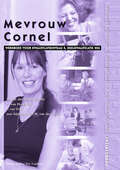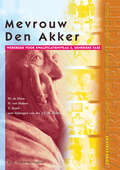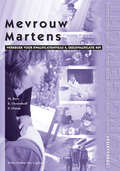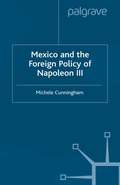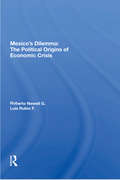- Table View
- List View
Metropolitan Income Growth and Convergence
by Roberto J. CavazosThis title was first published in 2001. What determines urban growth? Much has been written on particular causes and incidents which can explain the rise of one metropolis and the fall of another, but these do not illustrate general tendencies. This volume asks whether theories used to explain economic growth of nations or regions can be employed to find characteristics which encourage the growth of cities. Cavazos tests two principal theoretical approaches in this way. The first, the endogenous growth theory, predicts that incomes will diverge and sees technological innovations as the engine of economic growth. The second, the neoclassical growth theory, predicts conditional convergence and rates capital accumulation as the key to economic growth. He uses the two models to study US metropolitan income growth between 1970 and 1990 and compares their performance to determine which provides more insightful explanations of metropolitan growth.
Metropolitan Innovation Systems: Theory and Evidence from Three Metropolitan Regions in Europe (Advances in Spatial Science)
by Manfred M. Fischer Javier Revilla Diez Folke SnickarsThis book presents the fmdings of a comparative study of three European metropolitan regions: Vienna, Barcelona and Stockholm. The heart of the work consists of empirical studies carefully designed and developed in order to identify the main actors and mechanisms supporting technological innovation in each of the metropolitan regions. The authors have also highlighted the similarities and differences across regions and countries, investigating how these came to be, and discussing the possible implications. The introductory as well as the concluding Chapter was written by Manfred M. Fischer who, assisted by Attila Varga, was also responsible for Chapter 2 on the Metropolitan Region of Vienna. Javier Revilla Diez contributed Chapter 3 on the Barcelona Metropolitan Region. Folke Snickars has provided Chapter 4 which examines the Metropolitan Region of Stockholm and. All authors have reviewed and commented on the whole contents so that the volume represents a collective endeavour which has been rendered as homogeneous as possible. A particular effort has been made to ensure that the study is based on a common conceptual framework.
Metropolitan Planning in Britain: A Comparative Study (Regions and Cities #19)
by Peter Roberts Kevin Thomas Gwyndaf WilliamsMetropolitan Planning in Britain is the first comparative analysis and assessment of metropolitan areas and their strategic planning for almost two decades. Changes in population distribution, styles of local government, business practices, and attitudes to the environment have all had an impact on cities in recent years which planners and other policy makers must take into consideration. Based on a series of research projects and the activities of a study group supported by the Regional Studies Association, the book examines in detail nine major urban areas, their specific characters and requirements, and how metropolitan planning is adapting to fulfil those requirements. It also discuses the possible future evolution of metropolitan planning, especially in the light of new regional arrangements and devolution.
Metropolitan Planning in Britain: A Comparative Study (Regions and Cities)
by Peter Roberts Kevin Thomas Gwyndaf WilliamsMetropolitan Planning in Britain is the first comparative analysis and assessment of metropolitan areas and their strategic planning for almost two decades. Changes in population distribution, styles of local government, business practices, and attitudes to the environment have all had an impact on cities in recent years which planners and other policy makers must take into consideration. Based on a series of research projects and the activities of a study group supported by the Regional Studies Association, the book examines in detail nine major urban areas, their specific characters and requirements, and how metropolitan planning is adapting to fulfil those requirements. It also discuses the possible future evolution of metropolitan planning, especially in the light of new regional arrangements and devolution.
The Metropolitan Poor Vol 4: Semifactual Accounts, 1795-1910
by John Marriott Masaie MatsumuraThis is a collection of primary materials on the metropolitan poor. It includes the writings of urban travellers and social reformers, and contains writings from the last five years of the 18th century, that is, from the time when the poor were first discovered as endemic to the nation.
The Metropolitan Poor Vol 4: Semifactual Accounts, 1795-1910
by John Marriott Masaie MatsumuraThis is a collection of primary materials on the metropolitan poor. It includes the writings of urban travellers and social reformers, and contains writings from the last five years of the 18th century, that is, from the time when the poor were first discovered as endemic to the nation.
The Metropolitan Poor Vol 5: Semifactual Accounts, 1795-1910
by John Marriott Masaie MatsumuraThis is a collection of primary materials on the metropolitan poor. It includes the writings of urban travellers and social reformers, and contains writings from the last five years of the 18th century, that is, from the time when the poor were first discovered as endemic to the nation.
The Metropolitan Poor Vol 5: Semifactual Accounts, 1795-1910
by John Marriott Masaie MatsumuraThis is a collection of primary materials on the metropolitan poor. It includes the writings of urban travellers and social reformers, and contains writings from the last five years of the 18th century, that is, from the time when the poor were first discovered as endemic to the nation.
Metropolitan Regions: Knowledge Infrastructures of the Global Economy (Advances in Spatial Science)
by Johan Klaesson, Börje Johansson and Charlie KarlssonMetropolitan growth has been dramatic in the past several decades, and today metropolitan regions are recognized as the main driving forces in national growth and development as well as in national and global innovation processes. The purpose of this book is to contribute to a better understanding of how metropolitan regions and their subsystems interact and compete, why they differ in their capacity to nurture innovation and growth, and how metropolitan policies must be designed to secure the region’s long-term vitality. To that end, it presents new contributions on theories of urban growth, institutions and policies of urban change, and case studies of urban growth prepared by international experts.
Mevrouw Cornel: Kwalificatieniveau 406
by M. Berge-Kajuffa, A. Hooydonk and F. TrigtDeze casus gaat over mevrouw Cornel, een 55-jarige vrouw die opgenomen wordt op een chirurgische afdeling in verband met een uterusextirpatie. Na de operatie is het ook de bedoeling dat mevrouw Cornel op korte termijn wordt nabestraald. In deze casus leer je zorgvragers verplegen die als gevolg van gynaecologische kanker een operatie hebben ondergaan. Ook leer je wat er komt kijken bij de behandeling van gynaecologische kanker.
Mevrouw Den Akker: Werkboek voor kwalificatieniveau 3, generieke fase (Zorggericht)
by M. de Haan Y. Smid N. van HalemHoofdpersoon in de casus is mevrouw Den Akker. Een oudere dame, die na een leven met haar echtgenoot, haar werk, de zorg voor de kinderen en allerlei activiteiten in de samenleving, nu in allerlei opzichten achteruit gaat en verzorgd moet worden. Een dame die je in menig verzorgingshuis zou kunnen tegenkomen. De specifieke zorg voor mevrouw Den Akker op het gebied van voeding en uitscheiding heeft in deze casus met het clusterthema "voeding en uitscheiding" speciaal de aandacht.
Mevrouw Martens: Werkboek voor kwalificatieniveau 4, deelkwalificatie 409 (Zorggericht)
by Mevrouw P. Ottink E. Oosterhoff M. KersZorgcategorie: Psychiatrische zorgvrager Setting: ThuiszorgKorte inhoud: Mevrouw Martens is een vrouw van 63 jaar, die zich midden in een moeilijke periode van haar leven bevindt. Een aantal jaren geleden overleed, na een korte periode van ziek zijn, haar echtgenoot. Zij waren toen meer dan vijfendertig jaar getrouwd. In de eerste jaren leek mevrouw Martens zich met hulp van haar dochters en kleinkinderen goed te herstellen. Maar nu worstelt ze met het verlies van haar man. Zij heeft veel van hem gehouden en heeft veel verdriet om het gemis. Daarnaast mist ze een doel om voor te leven. Mogelijk heeft mevrouw Martens deze ingrijpende gebeurtenis in haar leven toch niet goed kunnen verwerken. Het is haar niet gelukt om de draad weer op te pakken en om inhoud te geven aan haar leven. Zij bevindt zich in een vicieuze cirkel, waar ze op eigen kracht niet meer uit komt. Hierdoor is niet alleen haar stemming somber, maar is ze ook lichamelijk verzwakt.
Mevrouw Schouten: Werkboek voor kwalificatieniveau 4, deelkwalificatie 410 (Zorggericht)
by Nicolien van Halem C. OttenZorgcategorie: Kraamvrouw Setting: KraamafdelingKorte inhoud: Bij de meeste vrouwen verlopen de zwangerschap, de bevalling en de kraamperiode zonder problemen, maar niet bij alle. Hanneke Schouten is zo'n vrouw. In de loop van de zwangerschap moet zij steeds meer rekening houden met gezondheidsproblemen. Een geplande thuisbevalling wordt verplaatst naar het ziekenhuis en ook de bevalling en de eerste uren daarna verlopen niet zonder problemen. Hierdoor is ook het kraambed anders en op een andere locatie dan Hanneke en haar man van tevoren bedacht hadden.
Mexican Banking and Investment in Transition
by John A. AdamsBanking and investment in Mexico have changed radically over the past decade, and the economic events that prompted these changes will have a significant impact on Mexico's role in regional and world financial markets. Adams traces the evolution of Mexico's banking and investment activities, reviews current conditions and their implications for future investment opportunities in Mexico, and makes clear that what happens to Mexico's economy and political stability will have major implications for what happens elsewhere in the world. One of the first books to look at banking and investment in Mexico after the peso crash of 1994-1995, with a highly detailed bibliography and notes, Adams's study will be important reading for international business, finance, and investment professionals and for their colleagues with similar interests throughout the academic community.The fate of both Mexico and the United States is that the two countries are forever tied by geography. The historical evolution of the dual interaction between the peoples of these two nations is and will be significant for the future of both countries. With this in mind, the book is divided into chapters reviewing such themes as the interaction and historical financial events that transpired during the advent of the North American Free Trade Agreement (NAFTA) and the expansion of cross-border financial and investment services, as well as a framework and background review of the events leading up to and resulting from the devaluations of the 1970s and 1980s, and more recently the evolution of the peso crisis of 1994-1995. The imperceptible yet gradual economic integration of the two economies has required time in developing, while not always being seamless in its implementation and transition. American macroeconomic policy has long had a direct impact on the economy of Mexico, as is evidenced by the impact of U.S. interest rates on the financial underpinnings of the Mexican treasury and the banking system to assist with the overall economic growth of the nation. An appreciation for the historically sensitive issues and perspectives, be they nationalization of the oil industry, immigration, or market access for foreign financial services, is paramount to a fuller understanding of doing business on both sides of the border.
Mexican Banks and Foreign Finance: From Internationalization to Financial Crisis, 1973–1982
by Sebastian AlvarezThis book is one of the first historical revisions of the Latin American debt crisis of 1982, exploring recently disclosed archival sources for a number of creditor and debtor institutions. It fills a gap on the national and international historiography on international finance in the 1970s and the Latin American debt crisis of the 1980s. The domestic banking approach in revisiting the 1982 financial crisis is a main distinction of this work and the consequences of the involvement of Mexican banks in international finance a major contribution to the literature. Beyond its thoroughly international approach, the book addresses a broad array of disciplines: financial history, political economy, international relations and business history. While the focus is on financial crisis, its implications extend to current regulatory and financial policy relative to crisis and non-crisis matters. In addition to providing a template for understanding other instances of financial crisis, the book points the way to research in a wide range of additional questions. These include the economic role of foreign capital, the transmission of financial crisis, and the decision criteria of states during crises. It also offers a strong example of the importance of politics in resolving economic problems. Because of this, the book will be of interest to historians, economists and political scientists.
The Mexican Heartland: How Communities Shaped Capitalism, a Nation, and World History, 1500-2000
by John TutinoA major new history of capitalism from the perspective of the indigenous peoples of Mexico, who sustained and resisted it for centuriesThe Mexican Heartland provides a new history of capitalism from the perspective of the landed communities surrounding Mexico City. In a sweeping analytical narrative spanning the sixteenth century to today, John Tutino challenges our basic assumptions about the forces that shaped global capitalism—setting families and communities at the center of histories that transformed the world.Despite invasion, disease, and depopulation, Mexico’s heartland communities held strong on the land, adapting to sustain and shape the dynamic silver capitalism so pivotal to Spain’s empire and world trade for centuries after 1550. They joined in insurgencies that brought the collapse of silver and other key global trades after 1810 as Mexico became a nation, then struggled to keep land and self-rule in the face of liberal national projects. They drove Zapata’s 1910 revolution—a rising that rattled Mexico and the world of industrial capitalism. Although the revolt faced defeat, adamant communities forced a land reform that put them at the center of Mexico’s experiment in national capitalism after 1920. Then, from the 1950s, population growth and technical innovations drove people from rural communities to a metropolis spreading across the land. The heartland urbanized, leaving people searching for new lives—dependent, often desperate, yet still pressing their needs in a globalizing world.A masterful work of scholarship, The Mexican Heartland is the story of how landed communities and families around Mexico City sustained silver capitalism, challenged industrial capitalism—and now struggle under globalizing urban capitalism.
The Mexican Heartland: How Communities Shaped Capitalism, a Nation, and World History, 1500-2000
by John TutinoA major new history of capitalism from the perspective of the indigenous peoples of Mexico, who sustained and resisted it for centuriesThe Mexican Heartland provides a new history of capitalism from the perspective of the landed communities surrounding Mexico City. In a sweeping analytical narrative spanning the sixteenth century to today, John Tutino challenges our basic assumptions about the forces that shaped global capitalism—setting families and communities at the center of histories that transformed the world.Despite invasion, disease, and depopulation, Mexico’s heartland communities held strong on the land, adapting to sustain and shape the dynamic silver capitalism so pivotal to Spain’s empire and world trade for centuries after 1550. They joined in insurgencies that brought the collapse of silver and other key global trades after 1810 as Mexico became a nation, then struggled to keep land and self-rule in the face of liberal national projects. They drove Zapata’s 1910 revolution—a rising that rattled Mexico and the world of industrial capitalism. Although the revolt faced defeat, adamant communities forced a land reform that put them at the center of Mexico’s experiment in national capitalism after 1920. Then, from the 1950s, population growth and technical innovations drove people from rural communities to a metropolis spreading across the land. The heartland urbanized, leaving people searching for new lives—dependent, often desperate, yet still pressing their needs in a globalizing world.A masterful work of scholarship, The Mexican Heartland is the story of how landed communities and families around Mexico City sustained silver capitalism, challenged industrial capitalism—and now struggle under globalizing urban capitalism.
Mexican Immigration to the United States (National Bureau of Economic Research Conference Report)
by George J. BorjasFrom debates on Capitol Hill to the popular media, Mexican immigrants are the subject of widespread controversy. By 2003, their growing numbers accounted for 28.3 percent of all foreign-born inhabitants of the United States. Mexican Immigration to the United States analyzes the astonishing economic impact of this historically unprecedented exodus. Why do Mexican immigrants gain citizenship and employment at a slower rate than non-Mexicans? Does their migration to the U.S. adversely affect the working conditions of lower-skilled workers already residing there? And how rapid is the intergenerational mobility among Mexican immigrant families? This authoritative volume provides a historical context for Mexican immigration to the U.S. and reports new findings on an immigrant influx whose size and character will force us to rethink economic policy for decades to come. Mexican Immigration to the United States will be necessary reading for anyone concerned about social conditions and economic opportunities in both countries.
Mexican Immigration to the United States (National Bureau of Economic Research Conference Report)
by George J. BorjasFrom debates on Capitol Hill to the popular media, Mexican immigrants are the subject of widespread controversy. By 2003, their growing numbers accounted for 28.3 percent of all foreign-born inhabitants of the United States. Mexican Immigration to the United States analyzes the astonishing economic impact of this historically unprecedented exodus. Why do Mexican immigrants gain citizenship and employment at a slower rate than non-Mexicans? Does their migration to the U.S. adversely affect the working conditions of lower-skilled workers already residing there? And how rapid is the intergenerational mobility among Mexican immigrant families? This authoritative volume provides a historical context for Mexican immigration to the U.S. and reports new findings on an immigrant influx whose size and character will force us to rethink economic policy for decades to come. Mexican Immigration to the United States will be necessary reading for anyone concerned about social conditions and economic opportunities in both countries.
Mexico and the Foreign Policy of Napoleon III
by M. CunninghamNapoleon III's motives for intervening in Mexico in the 1860s were consistent with his foreign policy, which was based on his belief that free trade was the best foundation for peace. He saw the establishment of a friendly government in Mexico as an opportunity to expand that policy to encompass the world by ensuring European access to American markets, and preventing monopoly by the United States. His attempts to achieve this, however, were thwarted by his representatives in Mexico and the suspicions of his neighbours.
Mexico and the Post-2015 Development Agenda: Contributions and Challenges (Governance, Development, and Social Inclusion in Latin America)
by Rebecka Villanueva UlfgardThis interdisciplinary edited collection presents original analysis on Mexico's transition from the Millennium to the Sustainable Development Goals, departing from three main perspectives. In what areas did Mexico gain leverage and actually contribute to the debate around the proposed SDGs? What are the challenges for Mexico with regard to the SDGs? How to handle the issue of congruence/dissonance in Mexico's accomplishment of the MDGs in relation to the socioeconomic realities on the ground? The contributing authors examine what kind of state is needed to strengthen democratic politics and social justice, but also to improve the economic effectiveness of the state and thereby prospects for development. For Mexico, what is missing is a clear vision for creating a progressive, truly modern society where the notion of a social contract between the government and citizens could be established along the lines of a welfare state that is inclusive, sustainable, and transformative enough to tackle seriously the fundamental socioeconomic injustices dividing Mexicans.
Mexico's Dilemma: The Political Origins Of Economic Crisis
by Roberto Newell G. Luis Rubio F.This book analyzes the crisis Mexico experienced in 1982 on the basis of the historical evolution of Mexico's political and economic structures. The author’s purpose in writing this book is to provide an interpretation of Mexico's current problems in order to analyze what must be done to solve some profound dilemmas and to restructure Mexican society. The main dilemma Mexico faces is its vanishing consensus.
Mexico's Dilemma: The Political Origins Of Economic Crisis
by Roberto Newell G. Luis Rubio F.This book analyzes the crisis Mexico experienced in 1982 on the basis of the historical evolution of Mexico's political and economic structures. The author’s purpose in writing this book is to provide an interpretation of Mexico's current problems in order to analyze what must be done to solve some profound dilemmas and to restructure Mexican society. The main dilemma Mexico faces is its vanishing consensus.
Meyers Money Fest: Über den täglichen Wahn und Sinn an den Kapitalmärkten
by Frank MeyerKlug, bisweilen zynisch, manchmal schmerzhaft, aber immer sehr komisch – Meyers Money-Fest ist ein echtes Lesevergnügen! Herrlich politisch unkorrekt befasst sich der bekannte n-tv-Journalist Frank Meyer in seinem Buch pointiert, unterhaltsam und sehr persönlich mit dem »lieben Geld«. Lesen Sie zum Beispiel von … Sprengsätzen im Portemonnaie, Plansinn und Wahnsinn an den Finanzmärkten, »gezyperten« Konten, Absurdistan und dem Märchen der Gebrüder Bank, dem Efft-Efft-Spray gegen Verschwörer aus der dunklen Welt der Wirtschaft und Börse, von Klimbim, Klabauter und Klamauk vermeintlich richtiger, medial gestreuter Informationen. Auf humorvolle und satirische Weise erklärt Ihnen Frank Meyer in Kolumnenform das angeblich hochkomplexe Thema Geld verständlich und einfach. Wenn Sie jetzt denken, sich mit Geld zu beschäftigen sei langweilig, lästig und führt zu nichts, da es uns sowieso täglich zwischen den Händen zerrinnt – Meyers Money-Fest beweist Ihnen das Gegenteil. So ein Finanzbuch haben Sie noch nie gelesen!
Mezzanine Financing: Tools, Applications and Total Performance (The Wiley Finance Series)
by Luc NijsAn in-depth explanation of mezzanine finance Mezzanine finance products, which have grown increasingly popular in recent years, involve a unique and complex form of analysis because of their hybrid nature. Because mezzanine finance involves no collateral, it accentuates legal terms, term sheets, and contracts, in addition to depicting dynamics of both debt and equity. Experienced chairman, lecturer, and professor of investment banking Luc Nijs presents readers with a thorough description of product groups, structuring and pricing, and cultural discrepancies in terms of regulation and application in Mezzanine Financing: Tools, Applications and Total Performance. Nijs analyzes common triumphs and failures encountered in mezzanine financing, and he discusses techniques for risk analysis and risk mitigation. A final study of international capital markets, their products' relevance, attractiveness, and liquidity, and the effects on pure equity/fixed-income risk concludes the book. Conveys a professional's advice through case studies of various regions, industries and contexts Provides the only complete analysis of mezzanine finance as no other books take on the topic as their only subject Details an increasingly popular and globally relevant subject in finance Those seeking a detailed explanation of the complexities within mezzanine financing will encounter a professional account in Nijs's book.






